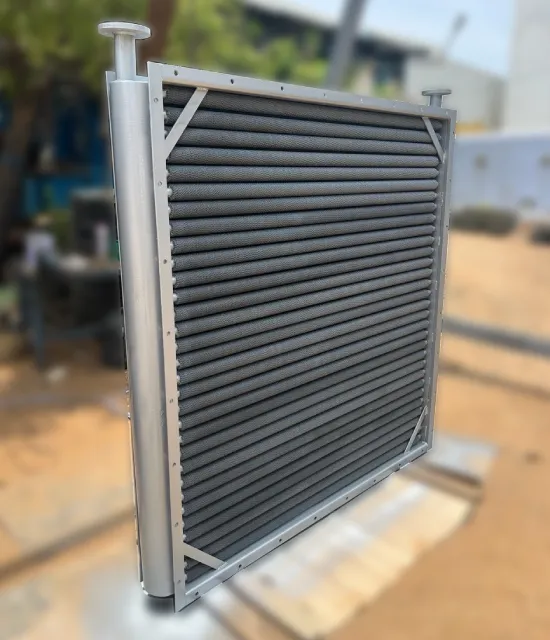about
Paddy Drier Heat Exchanger
A paddy dryer heat exchanger is a critical component in drying paddy (rice) efficiently. As one of the top paddy drier heat exchanger manufacturers, we ensure this specialized thermal transfer system ensures optimal moisture removal while preserving grain quality throughout the drying process.
Purpose of the Heat Exchanger
The primary role of a heat exchanger for paddy dryer systems is to transfer heat from hot air to paddy grains with precision and consistency, creating ideal conditions for moisture reduction without damaging grain structure. Our aluminium paddy dryer heat exchanger designs offer superior thermal conductivity for efficient heat transfer while reducing energy consumption, preventing issues like grain cracking and incomplete drying. As leading paddy dryer heat exchanger manufacturers, we've made our Heat Exchangers for Rice Mill Dryers the preferred choice for processing facilities focused on both product quality and operational efficiency, delivering improved rice quality, reduced processing times, and lower energy costs.

Working Principle of a
Heat Exchanger in Paddy Drier
Heat Transfer Mediums
- Hot Air: The major heating medium produced by a heat source or burner in the paddy dryer heat exchanger system.
- Paddy: The rice grain material that is subjected to the controlled drying process.
Heat Exchanger Types
- Air-to-Air Heat Exchanger: The most widespread design used in Heat Exchangers of Rice Mill Dryers, is when thermal energy is transferred between two independent air streams. Hot burner air warms the cold process air that comes in contact with the paddy.
- Air-to-Water Heat Exchanger: A second strategy wherein hot circulating water through the heat exchanger for paddy dryer systems is responsible for imparting heat to the process air, where water is generally preheated using a boiler.
Efficiency Considerations
- Temperature Management: Accurate temperature control in paddy dryer heat exchangers is imperative in order to avoid damage to grain while effectively evacuating moisture.
- Airflow Management: A correctly managed distribution of air across the grain bed insures homogeneous conditions of drying as well as high thermal transfer efficiencies.
- Recovery of Heat: State-of-the-art solutions in specialized manufacturers of paddy dryer heat exchangers offer integral heat recovery measures that save heat energy contained within exhaust air to substantially improve overall energy efficiency.
Operation Process
- Heating the Air: Burner hot air flows through one of the paddy dryer heat exchanger sections, providing a focused heat source.
- Airflow: Pre-conditioned or ambient air flows through individual passageways in the heat exchanger design without contaminating the heating air.
- Heat Transfer: Through the conductive walls, thermal energy is transferred as these airstreams flow through their respective passages, heating the process air to the exact temperature required.
- Drying the Paddy: This temperature-controlled air is then passed through the grain bed, providing the optimal conditions for evaporation of moisture without harming the fragile rice structure.
- Moisture Removal: The air rich in moisture leaves the system and fresh air enters, ensuring continuous drying until the grain is at optimal moisture content for storage or processing. Read More
Benefits
Energy Efficiency
Heat exchangers improve energy efficiency by maximizing the use of heat and reducing the need for additional energy inputs.
Consistent Drying
They help maintain a consistent drying temperature, which is crucial for high-quality rice.
Maintenance
Cleaning
Regular cleaning is necessary to prevent clogging and maintain efficient heat transfer.
Inspection
Routine inspections ensure that there are no leaks or damage to the heat exchanger.
Understanding the operation and maintenance of a Paddy Drier Heat Exchanger can help in achieving efficient and effective drying, ultimately leading to better quality rice and optimized energy use. If you have any more questions or need further details, feel free to ask!
Testimonials
Recently we bought a Radiators for our Generator. The Product Quality is Excellent .This Company produces custom made Radiators and Spares too. High Quality Products and Service Support.
krishna
CLEANTEK
We got support from ark engineering wonderful work done.He given idea for money save in genset. Ark engineering owner wonderful person.i will strongly recommend to ark engineering.
R.Prasannavenkatesh
Laser Experts India
Coimbatore
We have taken the services of the ark engineering for the service of our genset radiators.it was great Service at a better price .really professional and technical.
Suresh V
FAQ'S
What is the optimal temperature range for paddy drying using a heat exchanger?
The ideal temperature range for a paddy dryer heat exchanger is typically between 40-60°C, providing effective moisture removal while preventing grain cracking or quality degradation.
How often should a paddy dryer heat exchanger be cleaned?
Paddy dryer heat exchangers should be thoroughly cleaned after every 100-150 hours of operation to remove dust, chaff, and residue that can reduce thermal efficiency and potentially create fire hazards.
Can heat exchangers for rice mill dryers work with alternative fuel sources?
Yes, modern paddy dryer heat exchangers can be designed to work with various heat sources including biomass, agricultural waste, solar thermal systems, or conventional fuels depending on availability and cost considerations.